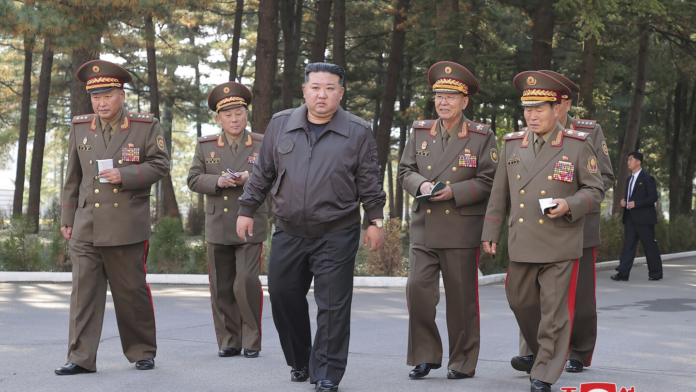Tensions between North Korea and South Korea have escalated once again as North Korea released photos of a captured South Korean drone. The latest incident is being seen as a significant provocation, with Pyongyang threatening to declare war if such “invasions” continue. The move comes amid mounting hostility between the two countries, which have long been locked in a state of heightened alert and political confrontation.
The photos, released by North Korean state media, showcase what they claim is a South Korean drone that allegedly breached their airspace. The North has claimed that such “spy operations” are an open act of aggression and could lead to military retaliation. This has only intensified the already volatile situation in the Korean Peninsula, sparking concerns of a renewed military conflict.

Rising Threats and Heated Rhetoric
The North Korean government has not held back in its verbal threats. In a statement issued by the Korean Central News Agency (KCNA), Pyongyang condemned South Korea for its “reckless espionage activities,” warning that if the South continues with such actions, it “would not hesitate to declare war.” The North’s leadership has always been quick to use threats of military action as a tool of intimidation, but the recent warnings are seen as particularly alarming due to the volatile nature of their regime.
Military experts have long pointed out that such drone incursions, if proven true, can be seen as a breach of sovereignty, especially in the context of North Korea, which views any military activity near its borders as a direct threat to its security. Kim Jong Un, the country’s supreme leader, has made repeated claims that North Korea is ready to defend itself against any external threats, and the release of the drone images is being positioned as further justification for its hardline military stance.
Escalating Tensions on the Korean Peninsula
This recent incident follows a pattern of aggressive posturing between the two Koreas. Earlier this year, North Korea conducted multiple missile tests, while South Korea has increased joint military drills with the United States, much to Pyongyang’s discontent. The back-and-forth provocation has pushed both nations to the brink of a potential armed conflict, as diplomatic channels remain largely frozen.
North Korea’s threats of war come at a particularly sensitive time, with US and South Korean military exercises increasing in frequency. North Korea has repeatedly denounced these drills as rehearsals for an invasion, further heightening the already tense situation.
A History of Conflict
The relationship between North and South Korea has been fraught with tension since the end of the Korean War in 1953. While an armistice ended the direct conflict, the two nations have technically remained in a state of war, as no peace treaty was ever signed. Periodically, hostilities flare up, often triggered by incidents such as cross-border exchanges of fire, military exercises, or accusations of spying.
This latest episode involving the alleged South Korean drone is just one in a series of provocative actions. Earlier this year, South Korea accused the North of cyberattacks targeting key infrastructure, while North Korea has pointed to South Korean surveillance efforts as further evidence of South’s “hostile intentions.”
What Could Happen Next?
The potential for military escalation on the Korean Peninsula is a very real concern. The US State Department has called for restraint, urging both North and South Korea to engage in diplomacy rather than military posturing. However, with Kim Jong Un issuing frequent threats, the room for negotiation appears to be shrinking.
The international community is closely watching the situation. If North Korea follows through on its threat to declare war, it would not only plunge the region into chaos but could also involve multiple global powers, including China, which maintains a close, albeit complicated, relationship with North Korea, and the United States, a long-time ally of South Korea.
Diplomatic Options Slim
Despite calls from the UN and other international bodies for de-escalation, the diplomatic options remain limited. North Korea’s isolationist policies and its pursuit of nuclear weapons have made it difficult for the global community to engage meaningfully with the regime. Meanwhile, South Korea, under the leadership of President Yoon Suk-yeol, has made it clear that it will not tolerate further aggression from the North, vowing to defend its territory at all costs.
The US and Japan have also voiced concerns about the potential for conflict, with Washington reaffirming its commitment to defending South Korea under their long-standing mutual defense agreement. Any escalation could quickly draw these nations into a broader conflict, with unpredictable consequences for global security.
The Role of Technology in Modern Warfare
The incident involving the drone raises important questions about the role of technology in modern warfare. Drones have become an integral part of military strategies worldwide, often used for surveillance or targeted strikes. However, their use also blurs the lines of conflict, as they allow nations to carry out covert operations without immediate detection.
In the case of North Korea and South Korea, the use of drones for reconnaissance purposes has been a growing issue. As military technology advances, so does the potential for new conflicts to arise from their use. North Korea’s reaction to the drone incident is a stark reminder of how technology can escalate existing tensions and lead to larger confrontations.
What Lies Ahead?
As tensions mount between North Korea and South Korea, the release of the drone images and the subsequent threat of war by Pyongyang have brought the region to a critical juncture. The international community, particularly the United States and China, must act quickly to mediate the situation before it spirals out of control. The Korean Peninsula remains one of the world’s most dangerous flashpoints, and the possibility of war is never far from the surface.
While North Korea’s threats may often be seen as bluster, the stakes are too high to ignore. The question now is whether diplomacy can prevail in time to prevent another catastrophic conflict on the Korean Peninsula.

